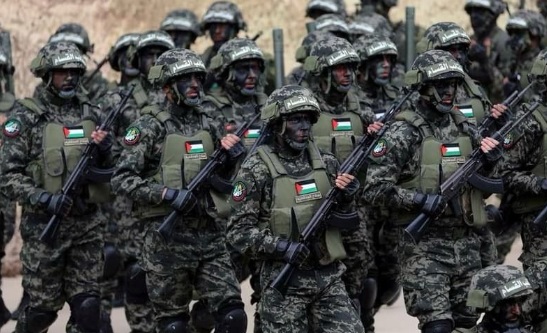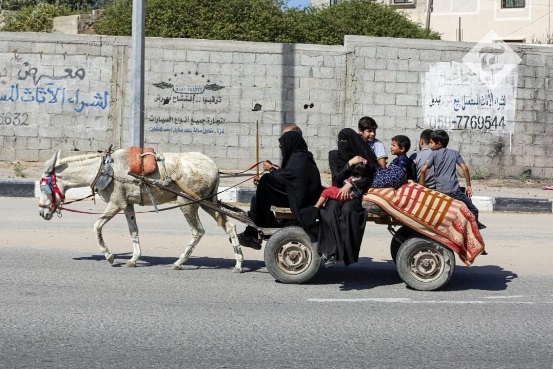Who is Hamas Blog
What’s the difference between Hamas and Islamic Jihad ?

Islamic Jihad Flag. Credit: Avi Dichter’s FB page.
In the complex tapestry of Middle Eastern politics, particularly in the Israeli-Palestinian conflict, two prominent players stand out: Hamas and Islamic Jihad. Both organizations, rooted in Islamic fundamentalism and nationalist sentiments, have played pivotal roles in shaping the conflict’s landscape. Despite sharing a common ideological lineage and overarching objectives, these groups differ significantly in their structure, approach, and impact on regional politics. This article delves into the intricate details of Hamas and Islamic Jihad, exploring their origins, ideologies, political objectives, and the distinct paths they have carved in the volatile environment of the Middle East.
Origins and Ideologies of Hamas and Islamic Jihad
Hamas:
Founded in 1987 as an offshoot of the Egyptian Muslim Brotherhood, Hamas emerged during the First Intifada. Its goal is to liberate Palestine from Israeli “occupation” in any way possible, and establish an Islamic state encompassing present-day Israel, the West Bank, and Gaza. Hamas is a multifaceted organization, encompassing a politburo, media, security services, and its military-terrorist wing, the Izz ad-Din al-Qassam Brigades.
Islamic Jihad:
The Palestinian Islamic Jihad (PIJ) was formed in 1982, influenced by Iran’s Islamic Revolution. Unlike Hamas, PIJ focuses solely on militant activities. Its primary aim mirrors that of Hamas: to establish an Islamic state in the region currently known as Israel and the Palestinian territories.
Governance and Military Structure of the organizations
Hamas’ Role in Governance and Military Tactics:
As the de facto ruler of Gaza post-2006 elections, Hamas oversees various aspects of governance. Militarily, it uses tactics like suicide bombings, rocket attacks, and incendiary balloon attacks. The Qassam rockets, with an estimated strength of 10,000-17,000 operatives, form the backbone of Hamas’s military might.
Hamas Terrorists. Credit: ‘Stand For Israel’ FB page.
Islamic Jihad’s Militant Focus:
PIJ, with its armed wing, the Al-Quds Brigades, lacks Hamas’s governance role. Its structure is more secretive and cell-based, focusing intensely on militant activities, including suicide bombings and rocket attacks.
Islamic Jihad terrorists. Credit: ‘Israel On Campus Coalition’s FB page.
Political Objectives and Approaches of Hamas Vs. Islamic Jihad’s
Both Hamas and PIJ reject Israel’s right to exist, often employing terrorism. However, their approaches differ:
Hamas has broader responsibilities in Gaza, balancing governance with militant activities.
Islamic Jihad operates more independently, sometimes undermining Hamas’s authority.
Funding and International Relations
Hamas:
Initially supported by donations from Gulf states and Islamic charities, Hamas now receives significant support from Iran and Turkey. Iran provides funds, weapons, and training, while Turkey offers political backing.
Islamic Jihad:
PIJ enjoys direct financial and military support from Iran, with most weapons being homemade. However, it has recently developed an arsenal almost rivaling that of Hamas.
Impact on the Israeli-Palestinian Conflict
Both groups significantly influence the conflict through violence and resistance against Israel. Hamas, with its dual role, impacts the socio-political landscape in Gaza as well as leading the fight against Israel as part of their political Agenda. Islamic Jihad’s aggressive stance often leads to confrontations both internally with Gaza’s governance and Israel.
Conclusion
Hamas and Islamic Jihad, while sharing some ideological similarities, differ in their structures, objectives, and tactics. Understanding these differences is crucial in comprehending the complexities of the Israeli-Palestinian conflict and the broader dynamics of Middle Eastern politics. Their roles as militant groups with varying degrees of governance responsibilities and their reliance on external support reflect the complex nature of the conflict in the region.
Who is Hamas Blog
Why can Hamas still sustain its existence in Gaza?

Hamas terrorists training. Credit: Informante FB page.
The presence and persistence of Hamas in the Gaza Strip is a subject of considerable complexity, involving intricate historical, socio-economic, and political elements. This article aims to unpack the layers behind Hamas’s continuous control in Gaza, examining its historical rise, the region’s social and economic landscape, media strategies, and the sources of its political support.
Historical Context: Hamas’s Ascent to Power
Hamas emerged in 1987 during the First Intifada, rooted in the Islamic Resistance Movement and driven by a vision of establishing an Islamic state in historical Palestine. Initially opposing the Palestine Liberation Organization’s secular approach and rejecting any compromise with Israel, Hamas advocated for a violent struggle. The organization gained significant ground in 2006 when it won the Palestinian Parliamentary election. However, its refusal to recognize Israel and renounce terrorism led to an international aid freeze, followed by internal political fights, led Hamas to take control of the Gaza Strip violently in 2007, marking a pivotal point in its history.
Social and Economic Conditions in Gaza
Hamas in Gaza streets. Credit: ‘Sahara Reporters’ FB page.
The socio-economic scenario in Gaza has always been critical to Hamas’s sustained control. The region, suffering under a blockade, faces economic challenges, high unemployment rates, and poverty. These hardships have created a fertile ground for Hamas to position itself as a key “social aid” fighter and a symbol of resistance against perceived oppression, appealing to the frustrated and desperate populace.
Hamas’s Media and Propaganda Tactics
Hamas throughout the years, has adeptly used media and propaganda to influence public opinion, both within Gaza and on an international scale. The group has full control over media content, especially targeting children and teenagers with tailored programming, to spread its ideology and maintain a support base. This strategy has been central to preserving its power, framing itself as a guardian of Palestinian rights and demonizing its adversaries.
Sources of Political Support for Hamas
Hamas’s political support is multi-faceted, with varying degrees of backing from different entities in the Middle East such as Iran, Qatar and lately Turkey as well. Initially, it established connections with groups like Hezbollah, and over time, it has received fluctuating support from regional players. The global perspective of most of the western countries on Hamas, consider it a terrorist organization.
Conclusion
The continuity of Hamas’s rule in Gaza can be attributed to a complex mix of historical, socio-economic, and political factors. Its ability to adapt to evolving conditions, combined with a constant effort to preserve difficult living conditions in Gaza, which led citizens to stay hopeless and full of anger, has enabled it to retain power and justification internally, despite significant international opposition.
Who is Hamas Blog
What do Gaza citizens think about Hamas?

Citizens of Gaza on a funeral. Credit: Yossi Davidov’s FB page.
In the complex geopolitical landscape of the Middle East, the Gaza Strip stands out as a region of intense focus, particularly regarding its control by Hamas. Since its inception, Hamas has been a polarizing force, eliciting varied responses from the international community and, crucially, from the citizens of Gaza themselves. This article delves into the nuanced and evolving perceptions of Gazans towards Hamas, exploring the group’s ascension to power, the changing attitudes of the Gazan populace before the massacre on Israeli civilians on October 7th, 2023, and the significant impact of Israel’s recent military responses on the Gazans, and their perceptions of Hamas. By examining these facets, we aim to provide a deeper understanding of the sentiments held by Gazans towards Hamas, a key player in the region’s intricate political and social fabric.
Citizens of Gaza on a funeral. Credit: Yossi Davidov’s FB page.
How Hamas Gained Leadership Over Gaza
Hamas, an Islamic terror group, has been ruling Gaza since 2007. This leadership was established through a combination of political maneuvering and force, notably after the triumph of Fatah in the last Palestinian parliamentary election in 2006. Hamas took the power from Fatah in a civil war.
Gazans’ Views of Hamas Before October 7th
Before the critical events of October 7th 2023, the views of Gazans towards Hamas were marked by growing dissatisfaction and despair, shaped by dire living conditions and a lack of political change. In 2018, amidst a backdrop of severe healthcare crises where 25% of women in Gaza faced life-threatening risks during childbirth and 53% of the population lived in poverty, the dissatisfaction with Hamas’ governance was palpable. Another study which was done, highlighted that nearly half of the Gazans wished to leave the strip entirely, reflecting a deep-seated sense of hopelessness.
In a more recent 2023 poll by the Washington Institute, a significant 64% of Gazans prioritized demands for improved healthcare, employment, education, and a semblance of normalcy, starkly contrasting with Hamas’ focus on “resistance.�? This sentiment was further underscored by an overwhelming 92% expressing outright frustration with their living conditions.
Moreover, a striking 73% of Gazans perceived the Hamas government as corrupt. With no elections held since 2006, a substantial portion of the Gazan population, having never voted for Hamas, saw little prospect for electoral change.
Reflecting on the past, when Hamas seized control over the Gaza Strip in 2007 after openly confronting the Palestinian Authority, over 73% of Palestinians, including Gazans, opposed the seizure and further armed conflict. At that time, support for military action against Israel was minimal among Gazans, with fewer than one-third endorsing such actions. Over 80% condemned acts of kidnapping, arson, and indiscriminate violence, highlighting a prevailing desire for peace and stability over armed resistance.
Impact of Israel’s Response to the 7th of October attack on Gazans’ views
The situation changed dramatically following the October 7, 2023 terror attack by Hamas on Israel and the subsequent Israeli military response. This response, involving significant bombardment, led to the destruction of homes and infrastructures, led to exacerbating the plight of Gazans. Many, including those who neither supported nor were members of Hamas, suffered greatly from these much-anticipated responses .
Conclusion: A Complex Dynamic
The current dynamics in Gaza highlight a complex and tragic situation. While the people of Gaza have long been critical of Hamas’ rule and have suffered under its governance, the Hamas terror attacks and actions have further complicated the situation, despite Hamas statements about their actions intended to protect the Palestinians and liberate them.
Who is Hamas Blog
Do Hamas leaders actually live in the Gaza Strip?

Hamas leaders on a private jet. Credit: Uzair Khattak’s FB page.
A common question that arises in discussions about Hamas and its leadership is the actual residence of its leaders. Contrary to what some might assume, many senior figures of Hamas, a group designated as a terrorist organization by several countries, do not reside in the Gaza Strip. This article delves into the current living arrangements of Hamas leaders, their historical journey to power, and the ascension of Ismail Haniyeh to the group’s leadership.
Where Are Hamas Leaders Living These Days?
Doha, Qatar’s skyline. Credit: ‘Hello Qatar’ FB page.
Senior leaders of Hamas, including Ismail Haniyeh, enjoy comfortable lives in countries like Iran, Qatar, Lebanon, and Turkey. In stark contrast to the dire situation in Gaza, these leaders live in luxurious conditions, far removed from the war and hardship. They manage significant operations from their foreign residences, including directing terrorist activities and engaging in international relations. This disparity highlights a significant gap between the experiences of the Hamas leadership and the everyday realities faced by the people of Gaza and that in fact, the lives of the people in Gaza and improving them, is not really part of their own financial equation.
The History of Hamas Leaders
The leadership of Hamas includes influential figures such as Ismail Haniyeh, Khaled Mashal, Mousa Abu Marzook, and Saleh al-Arouri, each with a distinct history within the organization. Ismail Haniyeh, after Hamas’ electoral victory in 2006, rose to leadership and was appointed as the Prime Minister of the Palestinian Authority in the Gaza Strip. Saleh al-Arouri became involved in Hamas leadership after his release from Israeli prison in 2010, establishing the Judea and Samaria headquarters. Khaled Mashal and Mousa Abu Marzook have also played vital roles in the organization’s international strategies and policies.
Who Is Leading Hamas These Days?
The current senior figures in Hamas’ foreign leadership include Khaled Mashal, Mousa Abu Marzook, Ismail Haniyeh, and Saleh al-Arouri, among others. These individuals are instrumental in orchestrating Hamas’ international strategies and maintaining its terrorist activities across various countries.
The Rise of Ismail Haniyeh
Ismail Haniyeh. Credit: Inbar Cohen’s FB page.
Ismail Haniyeh’s journey to the helm of Hamas’ leadership is a story of political ascent and increasing influence. Before Hamas‘ electoral victory in 2006, Haniyeh was not a prominent member of the group. Post-election, he rose to prominence, eventually being appointed as the Prime Minister of the Palestinian Authority in the Gaza Strip. His wealth grew substantially during his tenure, partly due to the control exerted over the Gazan economy and taxation policies.
Haniyeh’s Lifestyle and Controversies
Haniyeh, despite his position, leads a life of comfort in Qatar, far removed from the hardships faced by the residents of Gaza. This has drawn criticism from many, including Palestinians. His family, too, enjoys significant privileges and freedoms not available to ordinary Gazans. Reports suggest that Haniyeh’s wealth has allowed him to invest in various properties in Gaza and abroad.
Conclusion
The dichotomy between the living conditions of Hamas leaders and the people of Gaza is stark. While leaders like Haniyeh live in luxury abroad, the residents of Gaza face significant hardships. This disparity raises questions about the leadership’s connection to the realities on the ground and how much the lives of their own civilians really play any part in their offensive decisions.
-

 News2 months ago
News2 months agoGaza could Have Been Singapore. Hamas Turned It Into a living nightmare
-

 News2 months ago
News2 months agoRape, slaughter, and atrocities—see the real face of Hamas
-

 News2 months ago
News2 months agoKidnapping elderly and children: Hamas are no heroes
-

 News2 months ago
News2 months agoTrigger warning: This is the atrocity that’s happening in Israel right now
-

 News2 months ago
News2 months agoMonsters: Yahya Sinwar and Hamas kidnapped 150+ children and women.
-

 Hamas War Strategy, Tactics, and PR2 months ago
Hamas War Strategy, Tactics, and PR2 months agoThe War Crimes of Hamas and ISIS in Exploiting Civilians
-

 News2 months ago
News2 months agoShe died while saving lives.
-

 News2 months ago
News2 months agoHamas turns a music festival into a massacre






